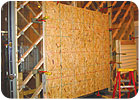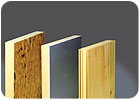
In an effort to more realistically quantify the energy performance of a variety of wall system alternatives under simulated “real-world” conditions, the National Association of Home Builders (NAHB) Research Center, through the labs of Architectural Testing Inc., of York, Pa., conducted a series of residential wall panel tests. The purpose was to compare the most common “baseline wall” (i.e., fiberglass batt insulation between 2 x 4 wooden studs finished with interior drywall) against several walls containing plastic building products (including foam plastic insulating materials).
R-value represents resistance to conductive heat flow, where higher numbers indicate increased thermal resistance. (In other words, the higher the R-value, the greater the insulating power.) Although R-value has been traditionally used in building codes for decades to quantify minimum insulation requirements for standard wall construction, it does not provide a complete accounting of the overall wall system’s energy performance. Effects such as thermal bridging of framing members, air and wind infiltration resistance, and stack effect on the building shell under normal, “real-world” operating conditions are not considered in the R-value.
This study is unique in its evaluation of overall wall system performance. It was designed to characterize the energy consequences of wall construction and insulation material choices under simulated wind pressure conditions. To more accurately represent various climates and “real-world” conditions, each wall system was tested under two conditions:
• in a “static state” condition with no additional atmospheric wind pressures at one outdoor temperature; and
• with a 15-mph “wind loading” at three different outdoor temperatures.

This wall panel is being tested for air leakage using ASTM E 283, Standard Test Method for Determining Rate of Air Leakage through Exterior Windows, Curtain Walls, and Doors Under Specified Pressure Differences Across the Specimen, standard procedures.
This study addressed the net effect of temperature and wind pressure differences across a variety of residential walls, comparing them to the most common “stick and batt” wall construction. The testing shows how a wall assembly would be expected to perform thermally while actually in use.
The test protocol was designed so the performance tests would be equitable for all the wall assemblies; additionally, the testing process was designed in such a manner to be repeatable. No two walls are made of exactly uniform materials due to factors such as wood warping, oriented strand board (OSB) thickness variations, and nail placement.
As such, special effort was made to ensure framing leakage through OSB sheathed walls was both reasonable and consistent (ASTM International E 283, Standard Test Method for Determining Rate of Air Leakage through Exterior Windows, Curtain Walls, and Doors Under Specified Pressure Differences Across the Specimen). Also, benchmarking was performed on each wall sample. The R-value of each individual material was tested (ASTM C 518, Standard Test Method for Steady-state Thermal Transmission Properties by Means of the Heat Flow Meter Apparatus, at 75 F (24 C) mean temperature) and from the material test results, a theoretical whole wall R-value was calculated for each wall that became its benchmark.
The benchmark was then compared to the actual whole-wall test results at Architectural Testing Inc. of York, Pa. (ASTM C 1363, Standard Test Method for Thermal Performance of Building Materials and Envelope Assemblies by Means of a Hot Box Apparatus). The ratio of actual performance of a wall system over a wall’s benchmark became the basis of comparison between the wall types. This enabled reasonable comparison of walls with differing R-values. This method fairly handicaps walls of various R-values to capture differences in performance of a wall system under different conditions. Conditions were representative of both typical and extreme “real-world” conditions in various climates.
Five wall types were assembled for whole-wall thermal testing. Plastic building products, such as plastic building wrap, plastic spray-in-place foam insulation, rigid foam plastic insulation, and structural insulated panels (SIPs) of foam plastic, were compared to the baseline wall’s benchmark construction (Table 1). Note: the R-value of spray polyurethane foam (SPF) may change after installation. To account for this possible change, the spray polyurethane foam (SPF) panels tested were warehoused nearly a year prior to the study.
The tested baseline wall represented the most common wall construction used in home building today (NAHB Research Center): a 2.4-m (8-ft) high, 101.6-mm (4-in.) overall thickness, wood-stud framed wall with studs spaced 406.4 mm (16 in.) on-center (oc), sheathed with OSB, R-13 kraft-faced fiberglass batt (KFB) insulation, and 12.7-mm (0.5-in.) drywall covering the inside. Furthermore, best installation practices and the manufacturers’ specifications were used. Individual insulation products were thermally characterized through alternate testing to validate the overall wall and material performance designations.
Since each plastic-insulated wall performed better than the baseline under windy conditions, it was concluded the performance values based on traditional R-value measurements and calculations are not a complete indicator of how well a wall system will resist the loss or gain of energy.
Summary
This laboratory testing clearly demonstrated the benefits of using plastic building products (including plastic foam insulation) by showing significantly improved energy performance of residential wall systems under “real-world,” wind-loaded conditions at various temperatures, compared to the baseline wall construction, as specified below.No wind and moderate temperature (static state)
When there is no wind at 70 F (21 C) inside and 25 F (-4 C) outside, all wall systems performed similar to their expected calculated benchmark. Compared to a typical batt insulation baseline, wall systems with plastic building products had a heat flow reduction of only 3 percent, which is not statistically significant.
Wind and extremely cold temperature
Under a 15-mph wind pressure, at 70 F inside and a temperature of -15 F (-26 C) outside, plastic building products and foam plastic-insulated wall panel systems reduced heat flow an average of 18 percent better than the baseline.
Wind and moderate temperature
Under a 15-mph wind, at 70 F inside and a temperature of 25 F outside, the performance results changed significantly. The wall systems with plastic building products overall reduced heat flow an average of 20 percent better than the baseline.
Wind and extremely hot temperature
Under a 15-mph wind, at 70 F inside and a temperature of 115 F (46 C) outside, wall systems with plastic building products reduced heat flow an average of 25 percent better than the baseline. One panel sample performed 29 percent better in this category.

One of the wall products tested in the study was the structural insulated panel (SIP), which typically comprises expanded or extruded polystyrene (EPS or XPS) or polyisocyanurate (polyiso) rigid foam insulation sandwiched between two structural skins or OSB.
Conclusion
An important finding is all the walls containing plastic building products performed similarly to the baseline wall with respect to reducing heat flow in the “no-wind” conditions. Interestingly, though, when wind conditions were applied, the research found all wall systems with plastic building products performed similarly better than the baseline. It also found that, as the temperature changed, all wall systems with plastic building products performed similarly better as a group to the baseline wall at each new temperature level.An important implication of this research indicates in order for a typical wall to meet the performance of a “plastic” wall under windy conditions, it would need to perform at least 15 percent better. This is equivalent to upgrading the wall insulation from R-13 to R-15. As mentioned earlier, the higher the R-value, the greater the insulating power. (Design professionals should ask an insulation distributor or manufacturer for a fact sheet on R-values.)
